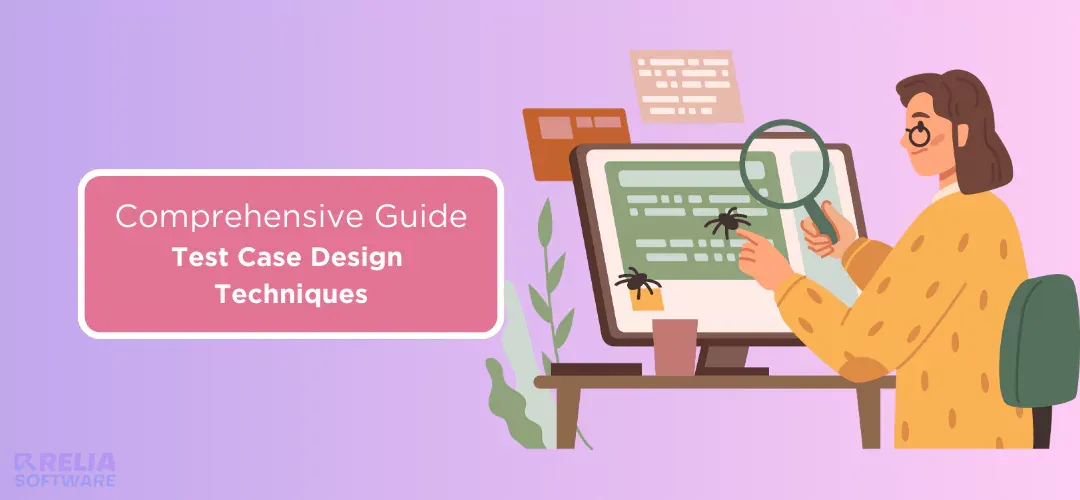Building high-quality software necessitates a thorough software testing methodology. At the core of this procedure is the development of effective test cases. It is essential to understand the test case design techniques to develop effective test cases. But what exactly are test case design techniques? And, how do you use them to design test cases successfully?
This article will analyze the world of test case design techniques, providing you with the information and tactics needed to create effective test cases that ensure the quality and reliability of your software applications.
>> Read more:
- Software Testing Life Cycle (STLC)
- 4 Levels Of Testing In Software Testing
- 7 Software Testing Principles
- Difference between Verification and Validation in Software Testing
What Are Test Case Design Techniques?
The test case design is a document that quality analysts create to specify the testing strategy, scope, and additional elements including testing prerequisites, test phases, postconditions, and expected results.
It also discusses the various variables to compare predicted and actual outcomes and decide whether the product fits the requirements. The goal is to maximize testing coverage to uncover any software faults and bugs that need to be fixed.
>> Read more: How to Write A Powerful Test Plan in Software Testing?
3 Typical Types of Test Case Design Techniques
Black-Box Testing Techniques
Black-box testing techniques concentrate on the external behavior of a software system while ignoring its internal workings. This method illustrates how real users would interact with the system, which aids in identifying flaws that may affect usability and functionality. Several important black-box testing techniques can be used to create effective test scenarios.
Equivalence Partitioning
Equivalence partitioning separates the input values into groups (partitions) and expects the system to act similarly. Test cases would then be created to check that the system performs properly inside each partition (for example, adding 50 things would be a valid test case, whereas adding zero items would be invalid). Steps for creating an equivalent partitioning test case:
-
Define the equivalence classes.
-
Develop test cases for each class.
Example: An e-commerce website might allow users to enter amounts ranging from 1 to 100 for each item added to their cart. An equivalence partition would be formed for valid quantities (1-99) and another for invalid quantities (less than 1 or larger than 100).

Boundary Value Analysis
Boundary value analysis is another type of black box testing approach. This technique focuses on determining the system's behavior at the edges or borders of the defined input values as well as invalid inputs that may cause problems.
Example: Continuing with the e-commerce example above, boundary value analysis would focus on the minimum and maximum allowable amounts (1 and 100). Test cases would involve entering these exact values, as well as values slightly above and below the bounds (0 and 101), to discover any difficulties with the system's handling of edge cases.
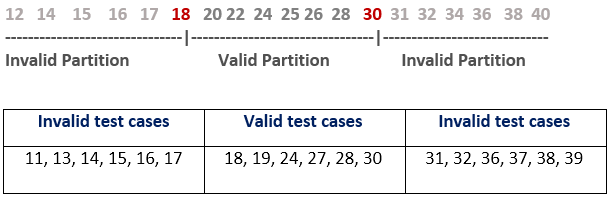
Decision Table Testing
This strategy is used to determine the software's behavior through many conditions. A decision table is developed to represent all potential combinations of conditions and their predicted results, which aids in the construction of test cases for each scenario. It employs a tabular format to methodically record these conditions and the accompanying system behaviors.
Here's a general overview:
-
A decision table normally contains two major sections: The condition section outlines the many input circumstances that can affect the system's behavior (such as username validity and password complexity).
-
The action section describes the desired result for each set of conditions (for example, successful login, and invalid password message).
This structured technique assists testers in visualizing and designing test cases to ensure the system performs as expected under diverse input combinations.
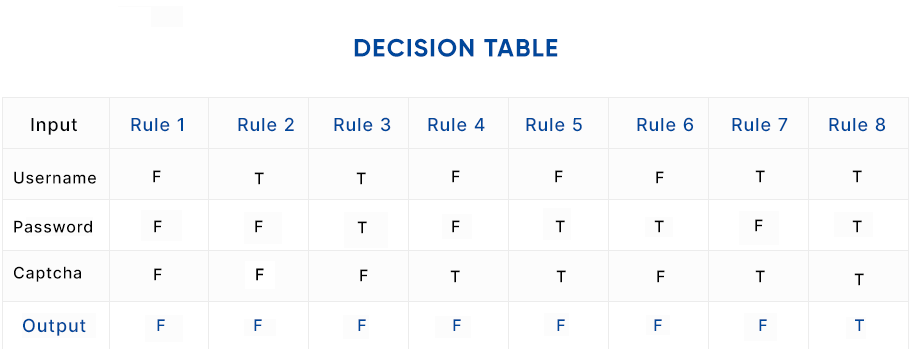
Use Case Testing
This technique focuses on evaluating software through the eyes of a user and their regular interactions with the system. Test cases are created based on the use cases specified in the program requirements.
Use case testing is another effective black-box technique. Use cases are thorough explanations of various functionalities that users can do in the system.
Example: A use case could be titled "Place an Order." Following this use case, test cases would be created from the individual processes involved in placing an order, such as logging in, adding products to the basket, going through the checkout process, and making a payment. Use case testing ensures that the entire functionality works properly by testing each step separately and sequentially.

State Transition Diagrams
It can be used for black-box testing when working with systems that have different states. These diagrams depict the various states that a system can be in, as well as the triggers or events that cause transitions between them.
Example: An ATM may be in different status such as inactive, entering a PIN, picking a transaction, or dispensing cash. State transition diagrams would aid in the development of test cases to validate the system's behavior as it moves between different states (for example, entering a valid PIN should cause the ATM to enter the transaction selection stage).
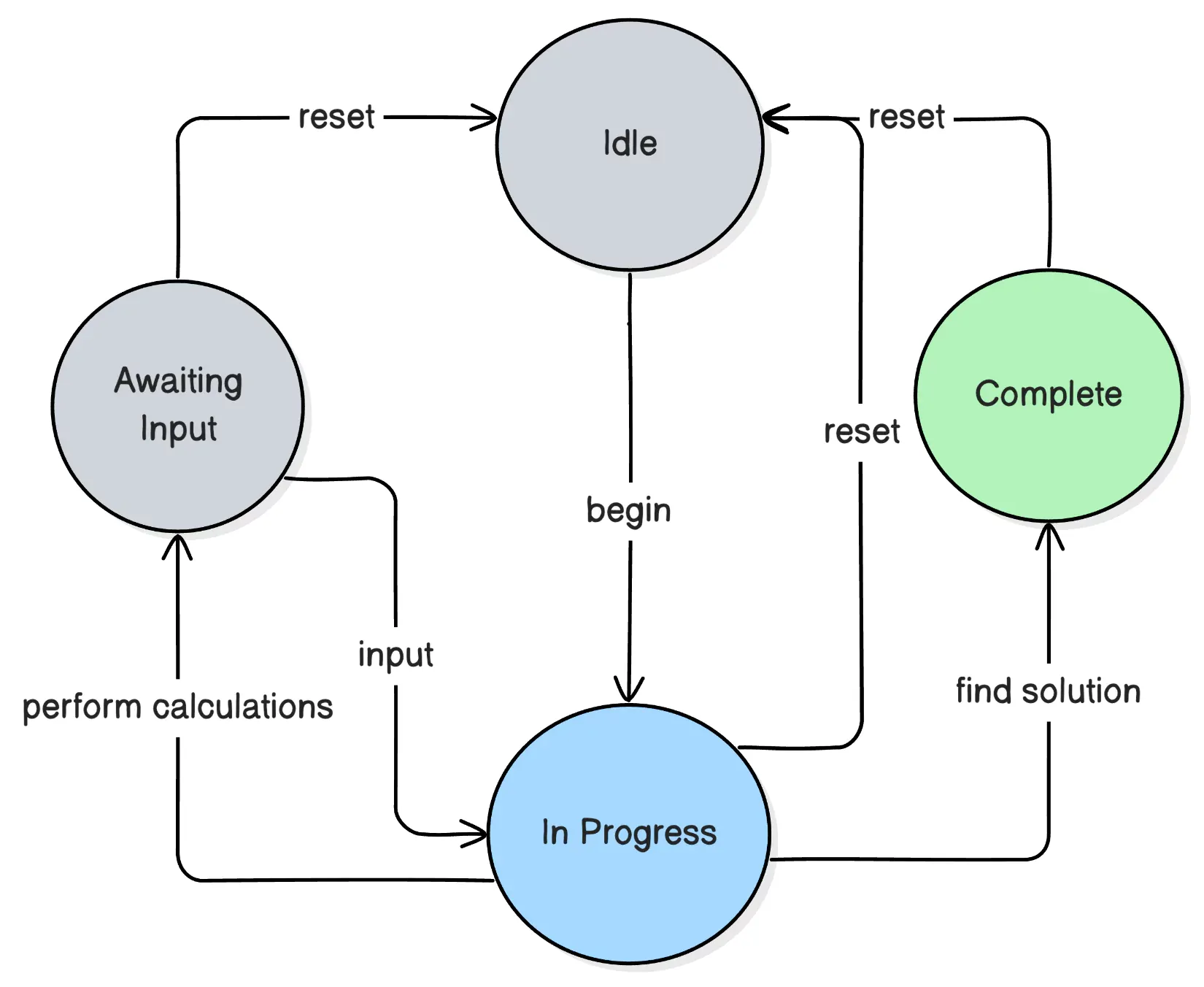
White-Box Testing Techniques
White-box testing approaches, also known as structural testing techniques, examine the inner workings of software. These techniques employ the software's code structure to create test cases that guarantee all code paths are performed and logical flows work properly.
Statement Coverage
This test case design technique guarantees that every executable line of code in the program is run at least once during testing.
Example: Consider a function that computes the area of a rectangle. Statement coverage would include test cases that use different input values (length and width) to execute each line of code within the function. This could contain test cases with legitimate dimensions, zero values, and negative values to guarantee that all aspects of the code are tested.
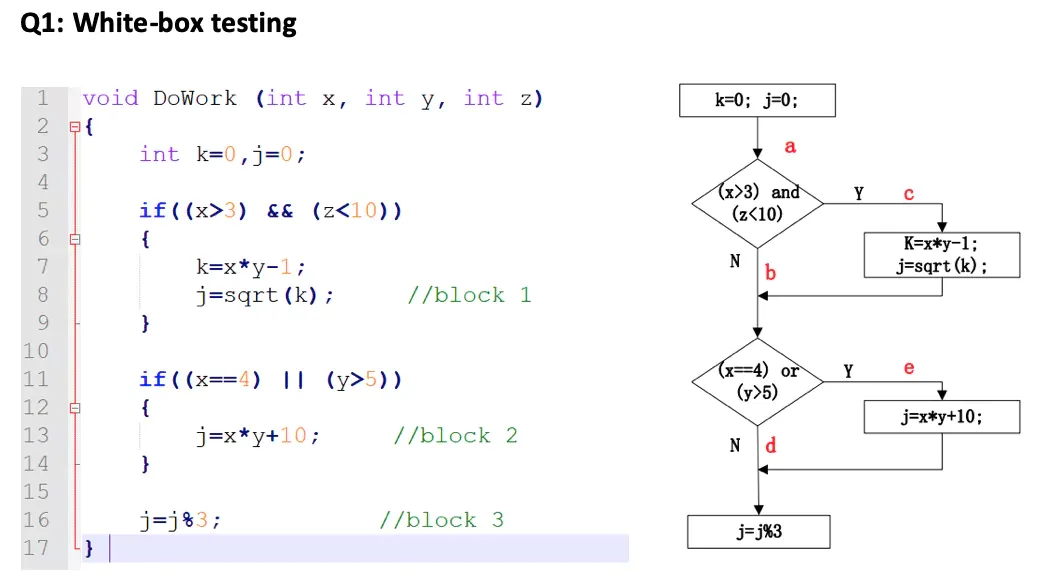
Branch Coverage
Branch Coverage aims to examine all possible execution routes within the code. This strategy entails ensuring that all decision points are activated by both true and false scenarios. It also ensures that every conceivable branch of the code gets tested at least once.
Example: Building on the rectangle area example, branch coverage would necessitate test cases that not only compute valid areas but also handle faulty inputs. This ensures that the code runs both branches of the conditional logic, checking whether it responds as expected when meeting unexpected data.
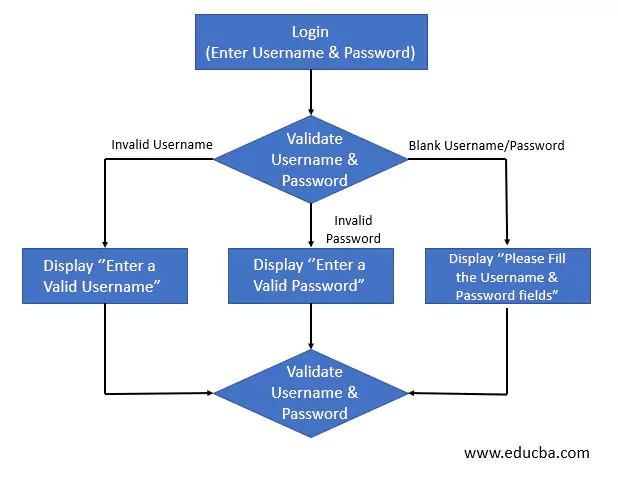
Path Coverage
Path Coverage attempts to carry out every conceivable path through the code, which can be especially difficult for complex code with many decision points and branching options. This technique ensures that all feasible execution pathways through the code are tried at least once during testing.
Example: Consider a function that includes two nested if statements. Path coverage would necessitate test cases that run all four combinations of true/false criteria for every statement. This ensures that all possible code execution pathways are tested, identifying vulnerabilities that may only happen under specific combinations of conditions.
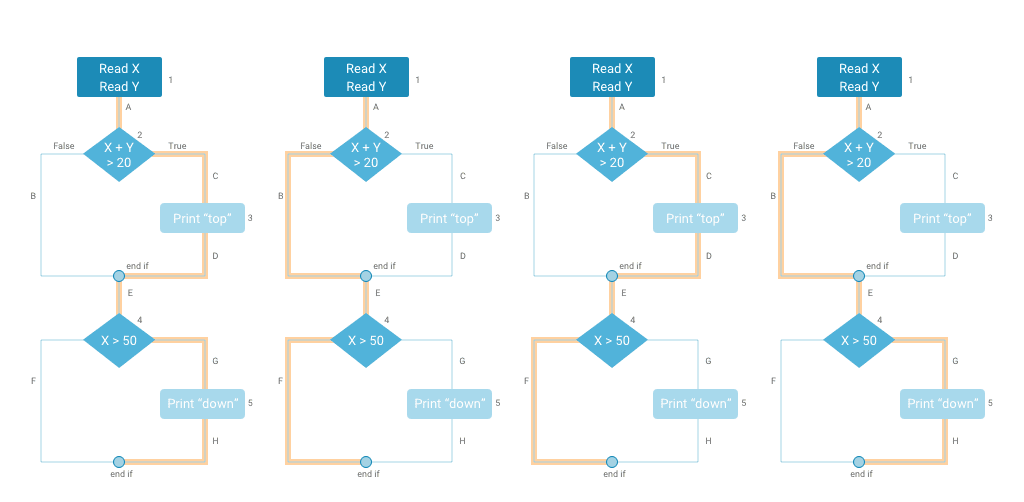
Data Flow Testing
Data Flow Testing examines how data values flow through the code, ensuring that data is properly processed and used throughout the program. This approach detects potential errors such as undefined variables, unreachable code sections, and accidental data changes.
Example: A function may compute the total cost of an order by multiplying the product quantity by the unit price. Data flow testing would include test cases that verify how these variables are used throughout the function. Test cases would focus on scenarios with missing values, zero quantities, and negative pricing to check that the data flows appropriately and yields the anticipated result.
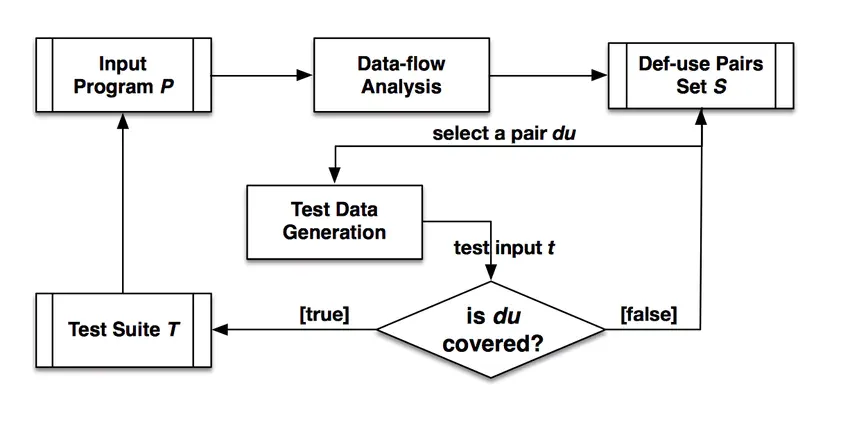
Experience-Based Techniques
Experience-based procedures use the testing team's knowledge and expertise to discover probable flaws in the program and create test cases based on previous experiences with similar applications or common software problems.
Error Guessing
Error Guessing is based on the tester's familiarity with typical software problems. This technique involves using the tester's experience to identify where mistakes may arise in the software and creating test cases to simulate those errors. This allows testers to create tailored test scenarios that expose potential weaknesses.
Example: A tester with experience in web application security might predict that a login form is vulnerable to SQL injection. They would next develop test scenarios specifically designed to expose this potential security problem.

Exploratory Testing
Exploratory Testing takes a more creative, session-based approach. Unlike following a pre-defined script, exploratory testing enables testers to actively interact with the product, learning and adjusting their testing technique as needed. This adaptable and dynamic approach can be especially useful in identifying unexpected challenges.
Example: Consider a tester starting their research of a new e-commerce site by adding items to a basket and buying. They may encounter unexpected behavior or usability concerns. They can then use these insights to navigate various functionalities and test situations to better understand the system.
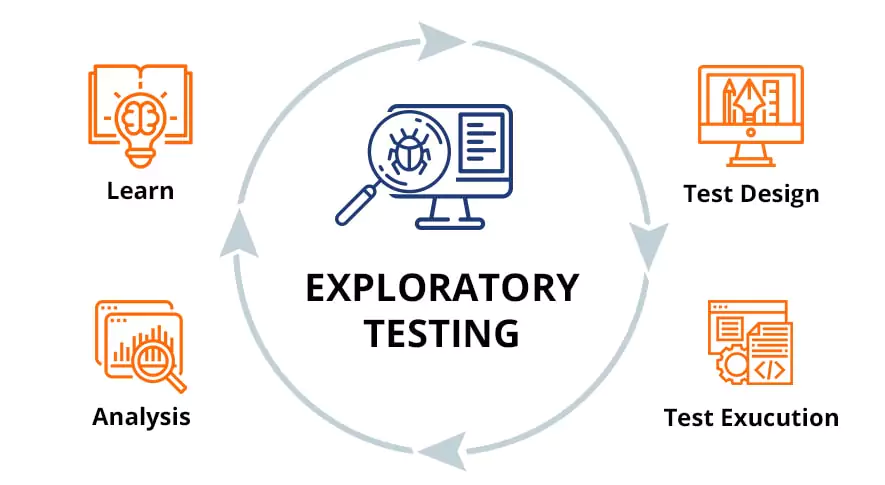
Usability Testing
Usability testing evaluates how people interact with software and identifies any usability bottlenecks that may impede their experience. While it has some similarities to exploratory testing, usability testing frequently involves user involvement and should be regarded as a separate technique.
Example: A new mobile app may be usability tested by a group of users. Users would complete app activities while their actions and feedback were recorded. This can uncover navigation, instruction clarity, and user experience flaws that other testing approaches may miss.

How To Choose The Right Test Case Techniques?
The correct test case design methodologies are essential for software quality, dependability, and user happiness. Choose the best testing methods for your project to maximize efficiency and reduce the chance of missed problems.
Here are some key factors to consider when choosing test case design techniques:
Understanding Your Software
-
Web Applications: Equivalence partitioning and use case testing are good for testing user-facing features and functions.
-
Safety-Critical Systems: In systems with serious failures, white-box methods like statement coverage and data flow testing are critical for code dependability.
-
Embedded Systems: This may require a comprehensive testing method including black-box and white-box techniques to access internal systems which is the best solution for embedded systems.
Project Requirements and Objectives
-
Focus on Core Functionality: Equivalence partitioning and use case testing can help you guarantee core functions work properly.
-
Performance Testing: Boundary value analysis may be needed to find performance bottlenecks.
-
Security Testing: It requires certain methods to find flaws. Experience-based error guessing for security concerns may be used.
Project Time and Resource
-
Time: Black-box methods are faster to implement than white-box methods. This is important for deadline-driven projects.
-
Resource Availability: Effectiveness in experience-based testing relies on tester competence. Remember to choose techniques based on your testing team's skills.
Prioritizing Risk Areas
-
Determine key software areas based on complexity or failure impact. Determine which methods best target these high-risk locations for targeted testing.
Adhering to Regulations
-
Testing methods may be regulated by some sectors. Make sure your methods meet industry standards.

Best Practice of Test Case Design
Here are a few best practices that QA engineers might follow when developing a test case.
-
The test case must accurately describe the steps and expected results of the testing process. Therefore, make the stages simple. Write in a straightforward style so anyone with documentation can understand test cases.
-
Make sure each test case has one intended result and it should be clear. If the same steps are used for different test cases, use a unique ID.
-
Always update test cases for new needs. Future QA engineers will find the document that is easy to understand, execute, and edit.
-
Stay within test limitations. Check the software requirement specification for tested features and functions. Act on demand, not intuition.
-
Automate test creation and management using artificial intelligence (AI). This improves test case tracking and maintenance.
>> Read more:
- AI in Software Testing
- Testing Beyond Features: Unlock Non-Functional Testing (NFT)
- Mastering Functional Testing for Delivering Bug-Free Software
- Differences Between Functional and Non-Functional Testing
- What is Integration Testing? Example, Approaches, Process
Conclusion
Effective test cases are not developed in isolation, they must be done through test case design techniques. Using a combination of black-box, white-box, and experience-based methodologies allows you to approach test cases from a variety of perspectives, revealing a broader range of potential flaws.
Relia Software provides QA and testing services to assist firms launch high-quality, user-friendly software. Our specialists design individual testing plans for each project using industry best practices and novel testing technologies. The commitment to quality and efficiency makes Relia Software a strong contender for your software testing needs.
>>> Follow and Contact Relia Software for more information!
- development
- testing
